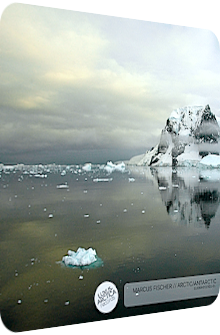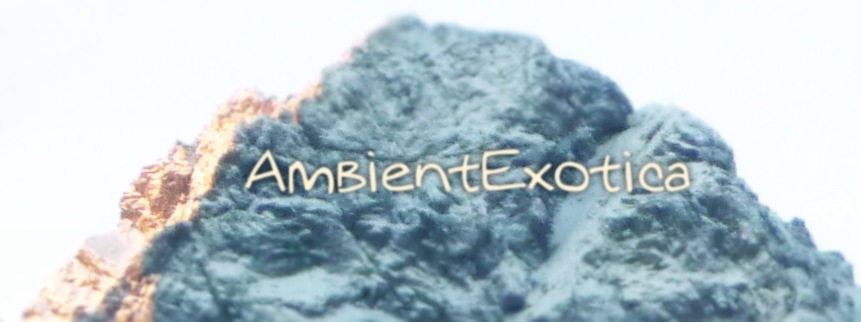
Marcus Fischer
Arctic/Antarctic
2010
To my knowledge, Arctic/Anarctic is Marcus Fischer's debut EP under his own name. Comprising of two three-track suites called Arctic and Antarctic with the mediating segue Tropica embedded in-between, this EP by the Portland-based multifaceted producer is a seldom mentioned and less known, but all the more important work, as many ideas which now form the base frame of Fischer's style are found here for the first time. In a way, Arctic/Antarctic harks back on concepts delivered on another EP called For Friends This Winter which Fischer created under his alias map~map for all of his close friends and the people who encouraged him over the years. This EP is available for free on Marcus Fischer’s Dust Breeding archive. Arctic/Antarctic, however, provides an in-depth viewpoint on the depicted landscape on the front cover. Released in June 2010 on the Luxus Arctica netlabel and available for free as well on the label's blog, Fischer uses tape-delayed sounds as well as acoustic guitar segments to let the ambiguously frosty warmth unfold. Interestingly enough, the first half of the EP is Drone-related, whereas the second half presents a decidedly electro-acoustic mélange with lots of spaces. If the latter description rings a bell, then you are familiar with his work, for this is the kind of analogue-focused music Fischer creates nowadays, and while this description is admittedly fuzzy, fans of his creations know what I am hinting at. Despite being released in June, this mini album is definitely an even better choice for the long nights of Winter.
Arctic/Antarctic launches with the suite of three numbered Arctic compositions. Arctic 1 is the longest take on the album with over eight and a half minutes of slowly growing glacial drone strings, an even icier seraphic synth creek that floats around their nexus and a majestic timbre that unites fragility with warmth. Arctic 1 proves the old saying that two negatives make a positive, for once the number of the drone strings is expanded and they conflate and mesh with each other, their aura is getting milder and warmer. I spare us all with the mathematical details, but this highly subjective realization is always surprising to me whenever I encounter it in supposedly harsh Ambient albums with an overarching winterly theme. Marcus Fischer boosts the number of frosty elements on Arctic 1 nonetheless: beautiful chimes and bells meet and depart, providing a second dichotomy in the second part of this track when they occur around the same time as a belly-massaging drone layer. It is here that the tonality shifts into gloomier, more tense realms, but as a treat, the composition ends with stretched notes in major and a scintillating fade-out phase. On Arctic 2, Fischer builds on this euphoric momentum and injects incredibly warm organ-like washes of the ecclesial kind. Underlining crackles of melting ice and a piercing polar string cannot fend off the thermal heat of the eminently positive vibe. Balmy unprocessed guitar strings waft around this aurora which is rounded off by a seemingly counteracting, but again heat-fueling layer of plinking ice shards in the distance. This one is for the Pop Ambient fans: encapsulating, entrancing, endergonic. Arctic 3 finishes the suite with the same amount of warmth, but expands the layers to the maximum in the forms of luminescent wraithlike synth washes and slightly tenser oscillating organ streams. The arrangement consists of anything but stretched gossamer sparkles and is utterly beautiful. Whereas Fischer’s later works – and the forthcoming Antarctic triptych – are build on a lacunar structure, with the amount and appearance of spaces and nothingness being as important as the textures of the sounds themselves, the first trio on Arctic/Antarctic turns out to comprise of Ambient tracks of the Drone subgenre and a few epicurean Glitch particles admixed.
Before the three-part Antarctica suite begins, a two-minute interlude or segue called Tropica is interwoven. From the wind chime-interspersed opening section over the ghostly but embracing guitar drones to the electro-acoustic bass injection, Tropica tries to mediate between the two suites by mirroring their respective qualities and motifs: gently putting counterintuitive devices and timbres of opposite spectrums in close proximity to each other and letting them unfold their contrastive traits. With this theme intact, Antarctic 1 is keen on the brighter side of things due to its pulse-like meandering synth waves of the glacial kind, coruscating sparkles and a wonderful sustain phase of the ubiquitous echoey reverb which fades into the distance where a monotonous synth aorta is swallowing it. The pulsating nature of the icy particles is sometimes a tad more hectic, but never does it cause an uneasiness or the loss of the contemplative panorama. Antarctic 2 is a pitch-perfect foreshadowing track in terms of Marcus Fischer’s approach he is nowadays known for, but not reducible to: mellifluous clouds of pink noise – remnants of the analog cassette tape structure used in the process of creation – are in close juxtaposition to an array of plinking guitar riffs which are allowed a similar fade-out phase. Instead of utter silence, the backing haze bolsters the quiescence and serves as a last whimsical remainder of a hazardous coldness in an otherwise pensive tune that would not have been out of place on his turquoise-cyan colored 2010 debut on the 12k label, the solemnly contemplative Monocoastal. Antarctic 3 is an addendum to Antarctic 2 and literally offers more of the same tranquil soundscape, with no distinct or additional element whatsoever. Even the ratio of guitar parts to the pink noise accents is equipollent to Antarctic 2. The album thus closes with the most important tracks that hint at the electro-acoustic path which Marcus Fischer followed after the delivery of this debut album under his own name.
Arctic/Antarctic does not show it in transparent clarity (yet), but the concepts of chance, contingency, accidental sound creations and ever-changing analog patterns are all in this EP already. This realization is not hinted at in the Arctic suite with the carefully built drone layers and its entanglement of both warm particles and strings with frosty molecules and chimes, but from the interlude Tropica onwards, the increasing amount of fissures and sustain-related fade-out phases comes into play all the better. Whichever of the seven tracks is running, there is always a peaceful grace apparent, and the incessant interplay – as well as the carved out independence – of the warmer guitar-related sounds and deeply rumbling drones with the crystalline iridescence of the pulsating chimes make this an ultimately warm release with colder structures. It is particularly interesting for those followers who are fond of both of Fischer's aesthetic driving forces, the Drone genre and the electro-acoustic concoction of sustain and space. Although Fischer never mentioned neither of the two genre distinctions, nor a reduction to the two of these, there is a melting pot-proposing tendency in his later works. Here, however, these forces are strictly separated, at least to my ears: Arctic features many drone layers without the clear-cut appearance of the guitar, and on Antarctica, it is vice versa. Since this album is available for free, there is no doubt about what to do next, right? Recommended for Winter evenings, but also applicable in warmer climes.
Further reading:
- Follow Marcus Fischer on Twitter: @mapmap.
- Cory Allen and Mike Vernusky talk to Marcus Fischer in great detail on their superb Quiet Design Podcast, episode 2, released on July 15th, 2012. A must-listen, very entertaining and yet analytical – with a special little guest who answers some important questions in the middle section of the podcast!
Ambient Review 159: Marcus Fischer – Arctic/Antarctic (2010). Originally published on Dec. 12, 2012 at AmbientExotica.com.
